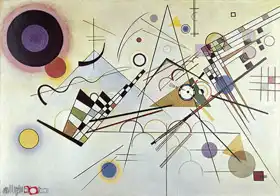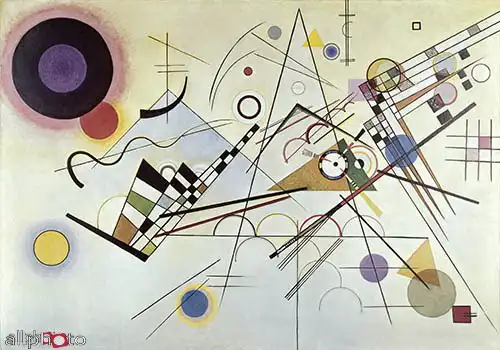About this finishing
Print. The image is printed on the top quality 10-ink HP Z9PS printer on HP matte 270 g / m2 paper. You can choose any size to an accuracy of 1 cm. A margin of 5 cm around the image is added to the size of the motif.


You can find a detailed description about our finishings
here.
Composition No. 8
Date:
1923Medium:
oil on canvasLocation:
Solomon R. Guggenheim Museum, New York, USADimensions:
201 x 140When
Wassily Kandinsky returned to his native Moscow after the hiatus created by the First World War, his expressive abstract style underwent a series of changes that reflected the artistic experiments of the Russian avant-garde. Many artists working with geometric figures began to create a universal aesthetic language, which inspired
Wassily Kandinsky to expand his native pictorial vocabulary. In Composition 8, colorful and playful geometric shapes create a pulsating surface that is simultaneously dynamic and calm, aggressive and quiet. The importance of the circles in this painting foreshadows their dominant role in
Kandinsky's later works. "The circle, " claimed the author, "is a synthesis of the greatest opposites. It combines centrality with eccentricity in one shape and balance. Of the three main formations, the circle most points to the existence of the fourth dimension."
Kandinsky painted picture Composition No. 8 in 1923. Prevailing color of this fine art print is vivid and its shape is landscape. Original size is 201 x 140. This art piece is located in Solomon R. Guggenheim Museum, New York, USA. This image is printed on demand - you can choose material, size and finishing.
Wassily Kandinsky (1866-1944). Russian painter and art theorist. One of the most famous painters of the 20th century. He gained fame through his abstract paintings. After the First World War, he moved to Germany, where he worked until 1933, when he fled the Nazis to France. He lived in France until his death. Kandinsky worked a long way to get to his abstract painting technique (he was fascinated by
symbolism and the psychology of colour). Kandinsky’s most famous works belong to the Bauhaus movement - an artistic movement of the 20s and 30s. It is characterized by sharp, geometric shapes (circles, wedges, triangles, etc.), clear colours and thoughtful treatment of surfaces. Perhaps the most famous work of this era is
Yellow - red - blue (1925).


